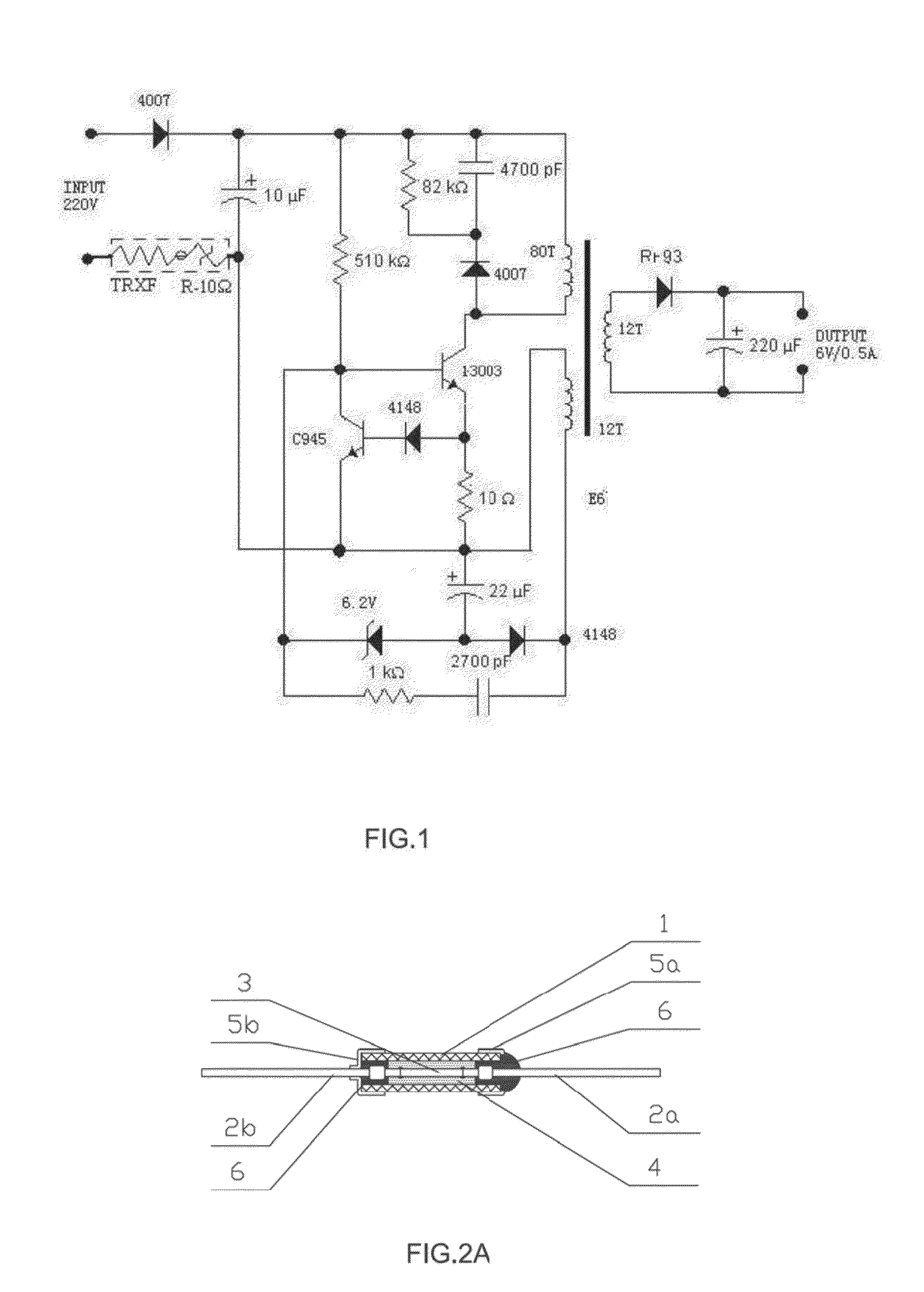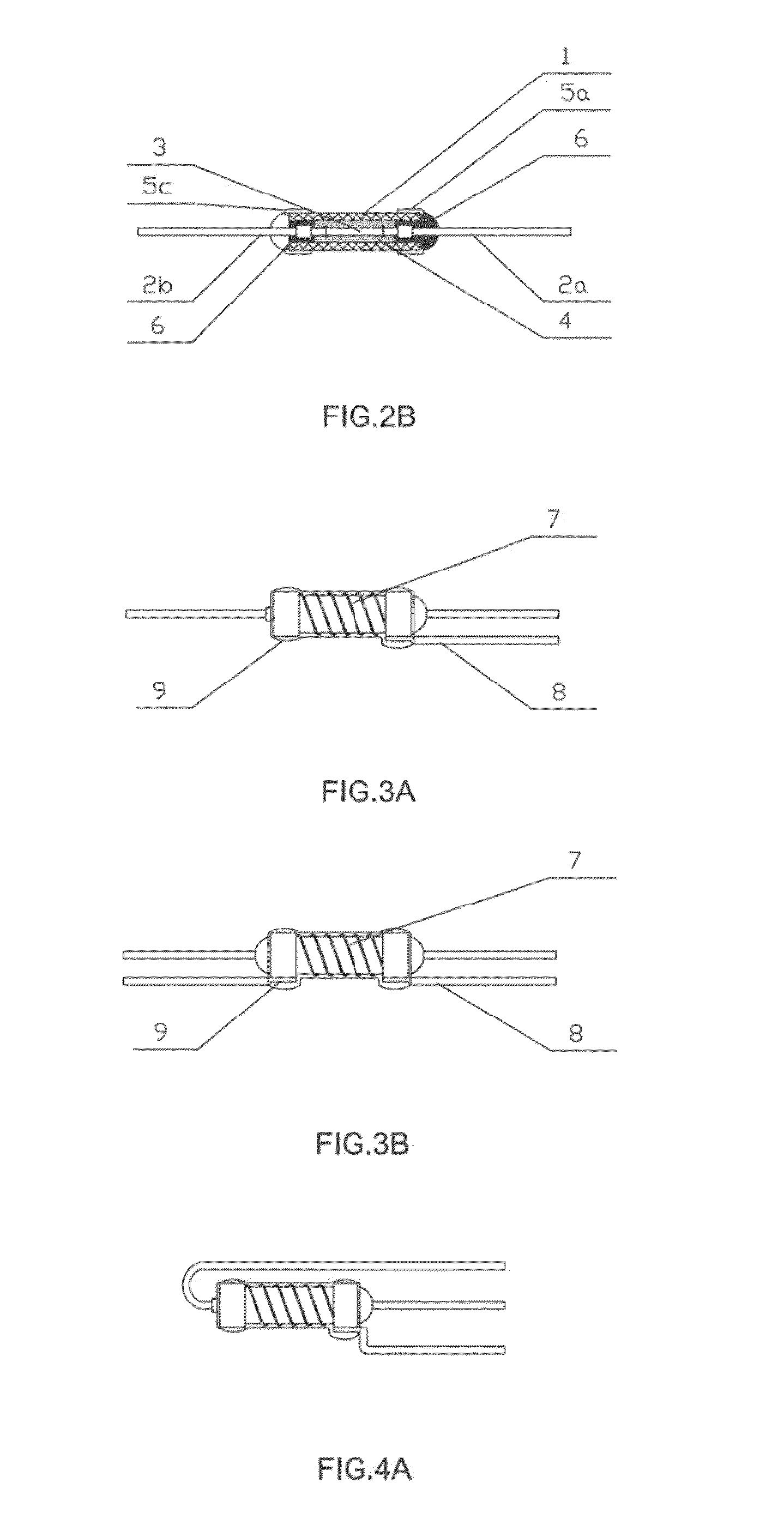Device combining a thermal fuse and a resistor
a technology of resistor and thermal fuse, which is applied in the field of resistor, can solve the problems of rapid rise of thermal fuse temperature, and achieve the effects of increasing the resistor value, improving the stability of the resistor value of the resistor, and reducing the heating temperature of the resistor
- Summary
- Abstract
- Description
- Claims
- Application Information
AI Technical Summary
Benefits of technology
Problems solved by technology
Method used
Image
Examples
first embodiment
The First Embodiment
[0021]The first embodiment will be further described with the FIG. 1, FIG. 2A and FIG. 3A. thereinto, the object of the embodiment is to describe the preferred embodiment of the present invention, but not limited.
[0022]FIG. 1 is the circuit of a switched power supply charger of a mobilephone or an MP3, and the circuit is applied with the device combining a thermal fuse and a resistor of the present invention; in FIG. 2A, the lead wires 2b, 2a of the thermal fuse is welded with low-melting point alloy wire 3. A fluxing agent 4 is disposed around the alloy wire 3 to improve the alloy wire to contract to two sides and cut off when molten, the thermal fuse, fluxing agent 4 and the alloy wire 3 form a whole under the normal temperature to be placed inside the ceramic tube, then two ends of the ceramic tube are encapsulated by epoxy resin 6 to be made into an entire thermal fuse.
[0023]As figured in FIG. 2A, when above thermal fuse is formed, put the metal caps 5a, 5b t...
second embodiment
The Second Embodiment
[0026]As figured in FIG. 2B and FIG. 3B, different from the first embodiment, the thermal fuse and the wirewound resistor are connected in parallel in a circuit, the wirewound resistor is wound to the ceramic housing of the thermal fuse. The lead wires of the metal caps (5a, 5c) in two ends of the wirewound resistor are not connected to the lead wires of the thermal fuse.
third embodiment
The Third Embodiment
[0027]The table below is the protection result data of the wirewound resistor with a thermal fuse in the first embodiment. In a high-frequency power supply, it often applies a 10Ω / 2 W wirewound resistor and a 221° C. thermal fuse against over-heat, the comparison of cut-off speed of the external contact type and the built-in type (the first embodiment) is as below. If single wirewound resistor is not added, high surface temperature for a long time is a hidden danger in the current in the table.
TABLE 1SurfaceSurfaceCut-off Time ofTemperature ofCut-off Time ofTemperature of thethe Externalthe Built-inthe Built-inTestExternal ContactContact TypeTypeType ThermalNumberCurrent AType Resistor ° C.Thermal Fuse SResistor ° C.Fuse S10.5142Not Cut-off in145Not Cut-off in600 s600 s20.5139Not Cut-off in142Not Cut-off in601 s601 s30.5146Not Cut-off in148Not Cut-off in602 s602 s40.5143Not Cut-off in145Not Cut-off in603 s603 s50.617536 s17618 s60.617437 s17719 s70.617836 s17618 ...
PUM
 Login to View More
Login to View More Abstract
Description
Claims
Application Information
 Login to View More
Login to View More - R&D
- Intellectual Property
- Life Sciences
- Materials
- Tech Scout
- Unparalleled Data Quality
- Higher Quality Content
- 60% Fewer Hallucinations
Browse by: Latest US Patents, China's latest patents, Technical Efficacy Thesaurus, Application Domain, Technology Topic, Popular Technical Reports.
© 2025 PatSnap. All rights reserved.Legal|Privacy policy|Modern Slavery Act Transparency Statement|Sitemap|About US| Contact US: help@patsnap.com



